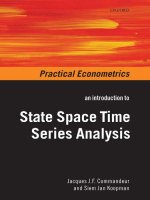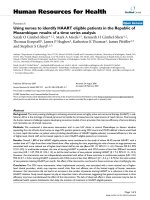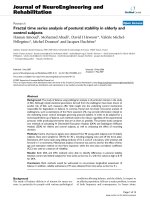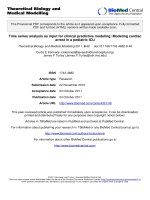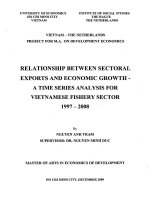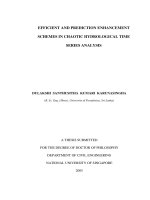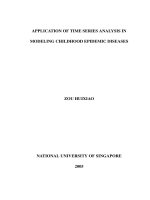Chapter 5 (time series analysis) student
Bạn đang xem bản rút gọn của tài liệu. Xem và tải ngay bản đầy đủ của tài liệu tại đây (204.29 KB, 62 trang )
CHAPTER 5
TIME SERIES
ANALYSIS
1
Time series data
Numerical
data obtained at regular
time intervals
The time intervals can be annually,
quarterly, daily, hourly, etc.
2
Example
Annual sales of a firm for 5 successive
years
Year
2000
2001
2002
2003
2004
Sales
75.3
74.2
78.5
79.7
80.2
3
Example
Number of registered journeys for a Home
Removals firm:
Qtr 1
Qtr 2
Qtr 3
Qtr 4
Year 1
73
90
121
98
Year 2
69
92
145
107
Year 3
86
111
157
122
Year 4
88
109
159
131
4
Time series cycle
General pattern which broadly repeats
Regularly occur but may vary in length
Often measured peak to peak or trough to
trough
1 Cycle
Sales
Year
5
Standard time series models
There are various types of model that can
be used to describe time series data.
Two main models:
Additive model:
y=t+s+r
Multiplicative
model
y=txSxR
y: is a given time series value
wher
e
t: is the trend component
s: is the seasonal component
r: is the residual component
6
Time series components
Time-Series
Trend
Component
Seasonal
Component
Residual
Component
7
Trend component
The underlying, long-term tendency of the
data series (overall upward or downward
movement)
Some techniques are used for extracting a
trend from a given time series: semiaverage, regression (least square method),
moving average…
8
Trend Component
Example
Sales
trend
d
r
a
Upw
Time
9
Trend Component
Trend can be upward or downward
Trend can be linear or non-linear
Sales
Sales
Time
Downward linear trend
Time
Upward nonlinear trend
10
Seasonal Component
Short-term cyclic fluctuation
Observed within 1 year (Often monthly or quarterly)
Sometimes observed within 1 week (daily)
Sales
Summer
Winter
Spring
Fall
Time (Quarterly)
11
Examples
Daily ‘seasons’ over a weekly cycle for
sales in a supermarket
Monthly ‘season’ over a yearly cycle for
the number of registered guests of a
resort.
Quarterly ‘season’ over a yearly cycle for
sales of confectionary.
12
Example
Number of registered journeys for a Home
Removals firm:
Qtr 1
Qtr 2
Qtr 3
Qtr 4
Year 1
73
90
121
98
Year 2
69
92
145
107
Year 3
86
111
157
122
Year 4
88
109
159
131
13
Year 1
Year 2
Year
3
Year 4
14
Residual component
Unpredictable, random, “residual”
fluctuations
Due to random factors such as
15
Time series trend
The underlying, long-term tendency of the
data series (overall upward or downward
movement)
The object of finding time series trend: to
enable the underlying tendency of the
data to be highlighted.
Techniques for extracting the trend:
- least square regression
- moving average
16
The method of least squares
regression
-
-
Consider the time series data as bivariate
The procedure for conducting the method
Step 1: Take the physical time points as
values of the independent variable x
(coded as 1, 2, 3, etc).
Step 2: Take the data values themselves
as values of the dependent variable y
17
The method of least squares
regression
-
Step 3: Calculate the regression line of y
on x, y= a+bx
Step 4: Translate the regression line as
t=a+bx, where any given value of time
point x will yield a corresponding value of
the trend, t.
18
Example
Estimate a trend line using regression
analysis
Year
1999
2000
2001
2002
2003
2004
Time
Period
(x)
1
2
3
4
5
6
Sales
(y)
20
40
30
50
70
65
19
Example
UK outward passenger movements by sea
(millions). Estimate a trend line using
regression analysis.
Qtr 1
Qtr 2
Qtr 3
Qtr 4
Year 1
2.2
5.0
7.9
3.2
Year 2
2.9
5.2
8.2
3.8
Year 3
3.2
5.8
9.1
4.1
20
The method of moving
average
The method of obtaining a time series
trend involves calculating a set of average
(known as moving average)
Each average is calculated by moving from
one overlapping set of values to the next
Used for smoothing seasonal variation
(length of period for computing means (L)
should be equal to the number of seasons)
- For quarterly data, L = 4
- For monthly data, L = 12
21
Notes
Each moving average value calculated must
correspond with an appropriate time point
(median of the time point)
- for moving average with an odd-numbered
period (3, 5, 7, etc), the relevant time point
is that corresponding to the 2nd, 3rd, 4th, etc
- for moving average with an evennumbered period, there is no obvious
corresponding time point. The technique
“centering” will be used
22
Moving average (odd-numbered
period)
Time
point
Original
data
1
2
12
10
3
4
11
11
5
6
9
11
7
8
10
10
9
10
11
10
Moving
totals
Moving
average
23
Moving average (even-numbered
period)
Time
point
Data
value
1
2
9
14
3
4
17
12
5
6
10
14
7
8
19
15
9
10
10
16
…
Moving
totals
Moving
averages
Centering
averages
24
Example
UK outward passenger movements by sea
(millions). Calculate trend value using
moving average centering.
Qtr 1
Qtr 2
Qtr 3
Qtr 4
Year 1
2.2
5.0
7.9
3.2
Year 2
2.9
5.2
8.2
3.8
Year 3
3.2
5.8
9.1
4.1
25


